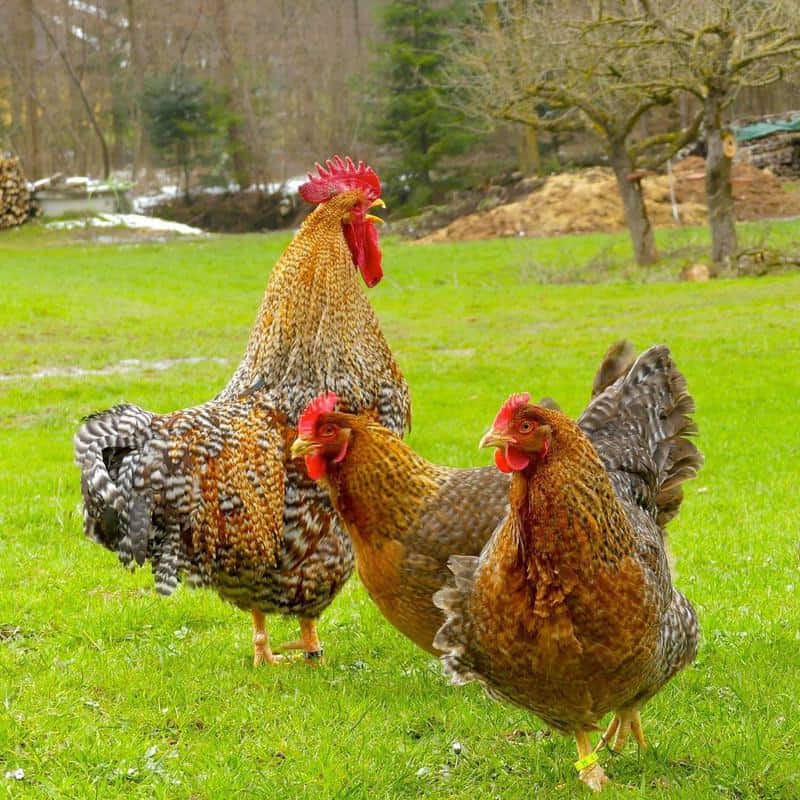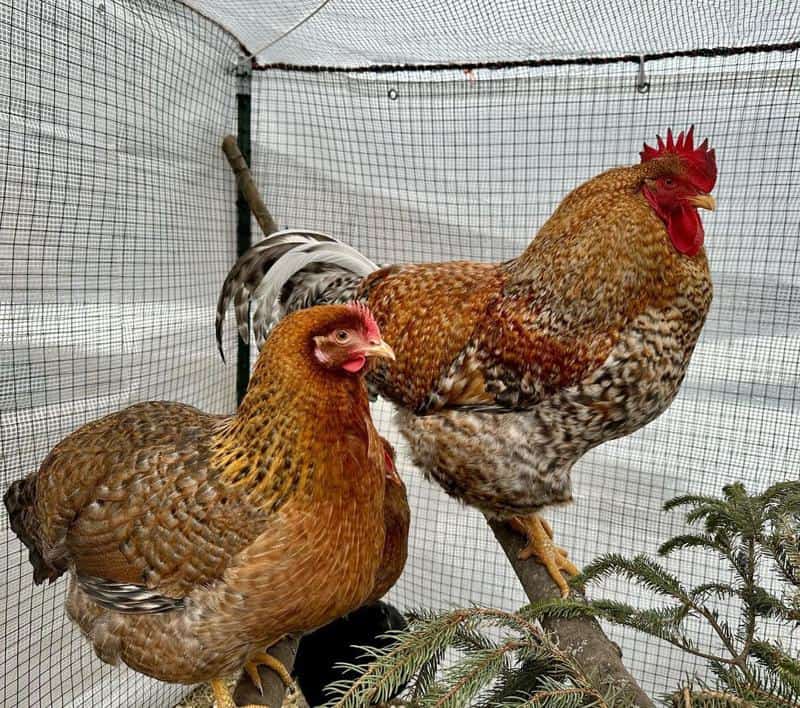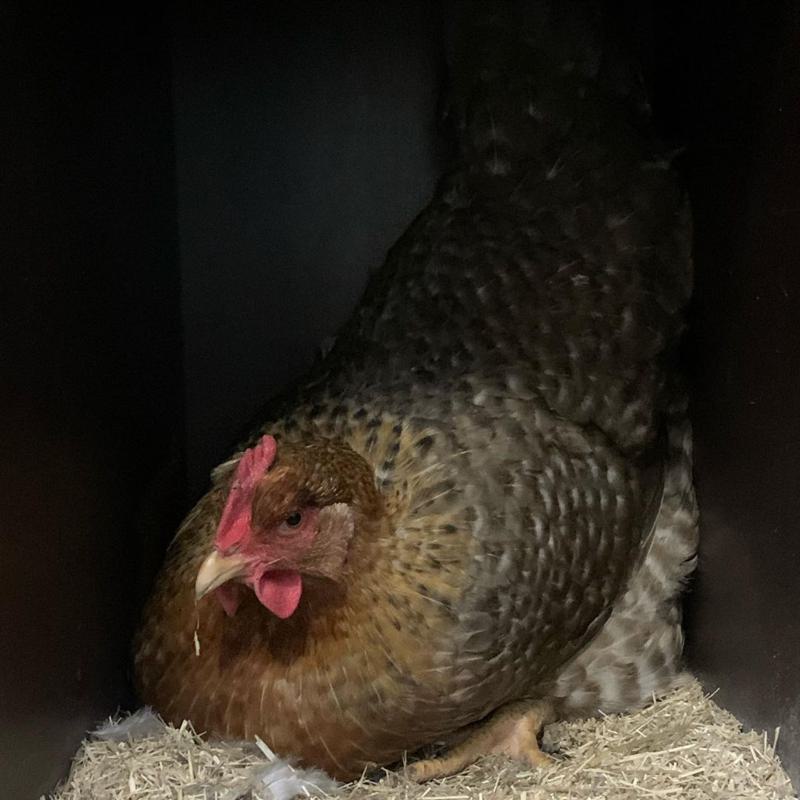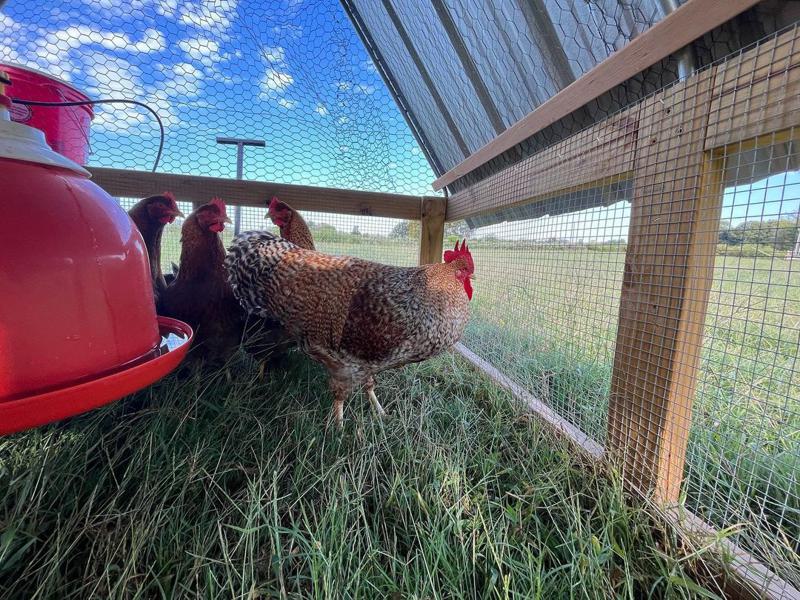While they’re a relatively new development, the Bielefelder chickens seem to have already captured the hearts of chicken enthusiasts and fanciers all over the world, and for a good reason!
These adorable feathered friends don’t just exude extraordinary beauty; they’re gentle giants whose larger-than-life disposition has made them one of the favorite options for backyard chicken keepers.
But do they truly qualify to become part of your backyard flock?
Well, that’s what we’ll be answering in this blog post.

Herein, we’ll take an in-depth dive into the world of the sweet Belefelder chickens, explicitly examining them from every angle, right from their origin and appearance to their egg-laying capabilities, housing requirements, and so much more.
Let’s jump right in!
Bielefelder Chicken Quick Facts:
Before we get into the detailed lowdowns of the Bielefelder chickens, let’s take a quick look at this summary table. It clearly highlights some of the key information regarding the breed.
| The Bielefelder Chicken Breed | |
| Origin | Bielefeld, Germany |
| Body size | Large |
| Weight | Standard: Roosters (9 lbs.), Hens (7 lbs.)
Bantam: Roosters (3 lbs.), Hens (2.5 lbs.) |
| Color of feathers | Crele and silver variety (similar to crele but without the red and yellow coloration) |
| Temperament | Excellent |
| Comb type | Single |
| Color of combs, wattles, and earlobes | Red |
| Skin color | Yellow |
| Feet type | Clean |
| Feet color | Yellow |
| Egg production | 220 to 280 eggs per year |
| Size of egg | Large to extra-large |
| Egg color | Brown |
| Dual purpose | Yes |
| APA-recognized | No |
| Autosexed | Yes |
| Health | Generally healthy |
| Weather-hardy | Yes |
Bielefelder Chicken History and Origin
Bielefelder chickens, also known as Bielefelder Kennhuhn, aren’t among the ancient breeds out there.
In fact, with this chicken having been developed in the early 1970s, it’s one of the novelty breeds in the poultry kingdom.
The creation work was done in Bielefeld, Germany, by a poultry breeder named Gerd Roth. Roth’s aim was to come up with an even-tempered chicken that would be weather-hardy and at the same time good at laying eggs and as a meat bird, and the Bielefelder chicken lived up to all these expectations and even beyond.
Roth crossed Barred Plymouth Rocks, New Hampshires, Dutch Welsummers, and Malines, and that’s how this bird, sometimes known as “super chicken”, was birthed.
Upon creation, the bird was named Deutsche Kennhuhn. However, this name was changed in 1980 after the breed was recognized by the German Pedigree Poultry Federation, and that’s when the name “Bielefelder” came in.
The chicken’s impressive attributes have fueled its popularity, crossing the U.S. borders recently in 2011. It’s yet to be recognized by the American Poultry Association (APA), but that doesn’t really make any huge difference for most chicken enthusiasts unless you intend to use the bird for showing purposes.
Body Size
The Bielefelder chicken is one of the large chicken breeds out there. Well, you may not compare its size to that of poultry giants like Brahma or the Jersey Giant, but you can expect them to be a tad bigger than the average chicken.
Like several breeds, the Bielefelders come in two sizes — the standard version and the bantams, sometimes referred to as the dwarf variety.
For the standard version, the roosters weigh about 9 pounds when fully mature, while the weight of the females is usually in the region of 7 pounds. As for the dwarf version, you can expect 3 pounds and 2.5 pounds for the roos and hens, respectively, way less than what the standard version weighs.
Appearance

On appearance, these chickens come in two color varieties. The first one is the crele variety, which basically is a cuckoo pattern with black-breasted red coloring. The second variety is silver coloring, which is also the most recent of the two.
These two color variants are somewhat similar in that their plumage creates a perfect camouflage with the surroundings, except that the silver variety doesn’t feature the red or yellow coloring you find in the crele variant.
The chicken has a single red comb, and the earlobes and the wattles are also red in color. The feet are clean without any feathers and are yellow, the same color as the bird’s skin.
But, of course, these are just general characteristics that may not apply to all Bielefelders, as individual variations within the breed still exist.
Temperament
Speaking of their disposition, it’s no doubt that Bielefelders are among the best chickens out there. In fact, their generally excellent temperament is perhaps one of the reasons they’ve exploded in popularity, considering they’re relatively new in the poultry realm.
Super Friendly
One of the great attributes of the Bielefelder chickens is that they value creating strong bonds with humans and other members of the poultry flock.
In fact, if you’re looking for a super-friendly chicken breed that can play a couple of roles in your home really well, including that of a perfect pet, not many chickens can replicate what you get from this breed.
They’re the kind of birds that will want to spend most of their time around you and won’t even mind perching on your laps for an extra treat. In other words, with Bielefelder chickens, expect a companionship that goes beyond the ordinary, often akin to that of a loyal canine.
Very Calm
Although their imposing size may initially seem intimidating, especially to the rest of the flock and kids, Bielefelders aren’t psychopathic birds. On the contrary, they’re extremely calm birds that generally exhibit a gentle disposition towards humans and other flock members.
Overly Protective
Sure, they’re super-friendly and docile chickens, but they are also overly protective, especially for the roosters.
The males are willing to put their life on the line to ensure the safety of the rest of the flock from predator attacks, with their huge size often bolstering their fearless defense capabilities.
Therefore, with Bielefelder chickens, you don’t just get perfect companions but also guardians that are willing to rise to the challenge whenever the rest of the flock is in imminent danger of getting preyed on.
Bielefelder Chicken Egg Laying Capabilities

The Bielefelder chickens are undoubtedly heavy layers. Usually, you can expect to get 4 to 5 eggs every week, sometimes even 6 eggs, translating to about 220 to 280 eggs per year.
The hens will begin producing eggs at about 22 weeks old, but there are some occasions when egg production may be delayed a bit. However, once they begin, they’re so good and consistent at it.
The chicken lays large to extra-large brown eggs. But it’s worth noting that this size sometimes isn’t apparent at the beginning of their egg-laying. Instead, some chickens will begin with small-sized eggs that gradually get large to extra-large.
Plus, Bielefelder chickens are cold-hardy, and that’s one of the things that set them apart from most chickens.
In other words, unlike some chickens whose egg production tends to decline when winter rolls around, Bielefelders’ egg-laying streak will carry on even during the chilly months.
The “unstoppable” egg-laying prowess makes them a strong candidate for anyone looking for a chicken breed that can reliably deliver a consistent supply of eggs even in the chilly days of the winter.
Even more, sometimes the eggs are double-yolked, which is a delightful surprise for chicken enthusiasts. But the probability of double-yoked eggs and the frequency at which they appear varies from chicken to chicken and is a matter of chance than an established formula.
Brooding
Bielefelder chickens don’t often go broody, which is another reason they make a thoughtful option for use as layers. But once they get broody, they become caring moms after the eggs hatch.
One thing worth mentioning here is that Bielefelder chickens breed true. That means when two Bielefelder chickens are mated, the resulting offspring will have the exact characteristics as the parents, generation after generation. It could be the color pattern, size, comb shape, feather type, or other characteristics specific to Bielefelder chickens.
Plus, Bielefelder chicks are autosex. That’s to say, you can visually tell the number of boys and girls the hen got immediately after hatching without having to wait for secondary sexual characteristics to show.
Once the hen has hatched, you should notice a white dot on the head and a blurry “chipmunk” pattern that runs from the chick’s head to the back if the chick is male. But if the “chipmunk” pattern is darker and more defined without any dot on the head, then that’s a girl chick.
Housing Needs

One thing about Bielefelder chickens is that they enjoy putting more miles on their feet each day. As such, ensure they have enough space to roam around if you want them to remain happy.
But again, that doesn’t mean they can’t thrive in enclosures. They still can, but these birds seem to find more pleasure in scratching and pecking at things as they navigate their surroundings, so allow them to free range if possible.
The color of their plumage provides exceptional concealment by perfectly blending with their surrounding, making them hard to be spotted by predators in their adventurous exploits.
In addition, besides providing adequate space to free range, ensure that their coop is well-designed with their needs in mind. It should be well-ventilated and spacious enough to keep them comfortable when inside.
The rule of thumb is to offer at least 4 square feet of space if having a standard breed, so stick to that at the very minimum. If you can offer more space, that’s even better, considering that Bielefelders are larger than the average chicken.
Of course, as frequent layers, you’ll also want to ensure that your Bielefelder chickens have a nice egg-laying spot. Get a nesting box or a couple of them, depending on the number of chickens they have.
Ideally, you should have a nesting box for every four chickens. This will save you from having to collect eggs from all over the place and losing some to egg predators. Of course, the nesting boxes have also to be large enough. Otherwise, they may not attract your birds.
Nutritional Needs
Bielefelder chickens are independent birds that will obtain a significant portion of their daily dietary needs through foraging. However, you still have to be sure they’re getting a well-rounded diet, especially considering they’re dual-purpose birds whose eggs and meat quality must be top-notch.
Due to their massive size, expect their daily food requirement to exceed that of most chickens, so be prepared to spend more on chicken food if you intend to add this breed to your flock.
You can use vegetables, fruits, and other food remains from your kitchen as a clever way to minimize the cost of bringing them up. Just ensure that their daily food constitutes at least 20% protein, especially if they’re still developing. This is to help them develop tissues to become the massive chickens they are.
For the layers, consider investing in calcium supplements. Getting large or even extra-large eggs is undeniably a pure delight per se, but the egg quality matters just as much, if not more. Enough calcium in your hens’ diet guarantees strong eggshells, minimizing chances of accidental breakages.
Of course, as you offer a healthy diet, remember that water quality also matters. Keep the waterers ever replenished with clean water if you want your birds’ health at an optimum state. The water containers should also be away from direct sunlight to minimize the chances of green algae forming.
And yes, remember to sanitize your waterers occasionally. Doing this will guarantee safe drinking water at all times for your birds and help combat any spread of water-borne diseases.
Common Health Issues
Bielefelder chickens are generally healthy breeds not inclined to any breed-specific health conditions. The breed is weather-hardy, meaning it’s less likely than some other breeds to get sicknesses from hot or cold weather conditions.
But that’s not to say they’re immune to diseases. These chickens can still get sick, just that this won’t happen often. As such, keeping your feathered friends on a healthy diet is essential.
Basic healthcare measures like vaccination are also imperative to maintain your flock’s health in tip-top condition.
And yes, like most other layers, Bielefelder hens can become egg-bound. It may not happen frequently, but keeping a close eye on your layers is imperative. It will help identify this condition immediately after it occurs so that you can take prompt measures to save your birds.
Pros and Cons of Bielefelder Chickens
Of course, Bielefelder chickens have a good and bad side that every chicken keeper needs to know. Getting acquainted with both sides of the coin will help you know whether they’re the perfect addition to your backyard.
Pros:
- Excellent disposition
- Independent
- Dual-purpose
- Autosex chicks
- Weather-hardy
- Easy to raise
- Generally healthy
Cons:
- Need more food
- Requires space to roam in for them to thrive best
- Not APA-recognized
- Scarce to obtain
Read More:
Conclusion
Bielefelder chickens are excellent chickens in many ways. No wonder they’re sometimes referred to as “super-chickens”.
These cute birds are dual-purpose with an excellent disposition and less susceptibility to diseases. They’re also easy to raise, thanks to their strong foraging instincts that give them some sense of independence.
However, ensure they get enough food and adequate space in their closures and when roaming outside. That way, they can live a happy and healthy life together with the rest of your flock.
